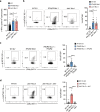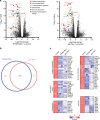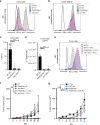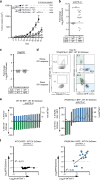Tumor heterogeneity and clonal cooperation influence the immune selection of IFN-γ-signaling mutant cancer cells
- PMID: 32001684
- PMCID: PMC6992737
- DOI: 10.1038/s41467-020-14290-4
Tumor heterogeneity and clonal cooperation influence the immune selection of IFN-γ-signaling mutant cancer cells
Abstract
PD-1/PD-L1 blockade can promote robust tumor regression yet secondary resistance often occurs as immune selective pressure drives outgrowth of resistant tumor clones. Here using a genome-wide CRISPR screen in B16.SIY melanoma cells, we confirm Ifngr2 and Jak1 as important genes conferring sensitivity to T cell-mediated killing in vitro. However, when implanted into mice, these Ifngr2- and Jak1-deficient tumors paradoxically are better controlled immunologically. This phenotype maps to defective PD-L1 upregulation on mutant tumor cells, which improves anti-tumor efficacy of CD8+ T cells. To reconcile these observations with clinical reports of anti-PD-1 resistance linked to emergence of IFN-γ signaling mutants, we show that when mixed with wild-type tumor cells, IFN-γ-insensitive tumor cells indeed grow out, which depends upon PD-L1 expression by wild-type cells. Our results illustrate the complexity of functions for IFN-γ in anti-tumor immunity and demonstrate that intratumor heterogeneity and clonal cooperation can contribute to immunotherapy resistance.
Conflict of interest statement
The authors declare no competing interests.
Figures








Similar articles
-
Chimeric antigen receptor engineered NK cellular immunotherapy overcomes the selection of T-cell escape variant cancer cells.J Immunother Cancer. 2021 Mar;9(3):e002128. doi: 10.1136/jitc-2020-002128. J Immunother Cancer. 2021. PMID: 33741731 Free PMC article.
-
Anti-PD-1 increases the clonality and activity of tumor infiltrating antigen specific T cells induced by a potent immune therapy consisting of vaccine and metronomic cyclophosphamide.J Immunother Cancer. 2016 Oct 18;4:68. doi: 10.1186/s40425-016-0169-2. eCollection 2016. J Immunother Cancer. 2016. PMID: 27777777 Free PMC article.
-
Bispecific Antibody Approach for Improved Melanoma-Selective PD-L1 Immune Checkpoint Blockade.J Invest Dermatol. 2019 Nov;139(11):2343-2351.e3. doi: 10.1016/j.jid.2019.01.038. Epub 2019 May 23. J Invest Dermatol. 2019. PMID: 31128201
-
Establishment of humanized tumor microenvironment mouse models based on the injection of peripheral blood mononuclear cells and IFN-γ to evaluate the efficacy of PD-L1/PD-1-targeted immunotherapy.Cancer Biol Ther. 2020;21(2):130-138. doi: 10.1080/15384047.2019.1670520. Epub 2019 Nov 6. Cancer Biol Ther. 2020. PMID: 31690181 Free PMC article.
-
ILT4 inhibition prevents TAM- and dysfunctional T cell-mediated immunosuppression and enhances the efficacy of anti-PD-L1 therapy in NSCLC with EGFR activation.Theranostics. 2021 Jan 19;11(7):3392-3416. doi: 10.7150/thno.52435. eCollection 2021. Theranostics. 2021. PMID: 33537094 Free PMC article.
Cited by
-
Bridging Radiotherapy to Immunotherapy: The IFN-JAK-STAT Axis.Int J Mol Sci. 2021 Nov 14;22(22):12295. doi: 10.3390/ijms222212295. Int J Mol Sci. 2021. PMID: 34830176 Free PMC article.
-
Maximizing the value of phase III trials in immuno-oncology: A checklist from the Society for Immunotherapy of Cancer (SITC).J Immunother Cancer. 2022 Sep;10(9):e005413. doi: 10.1136/jitc-2022-005413. J Immunother Cancer. 2022. PMID: 36175037 Free PMC article.
-
Spatial biology of cancer evolution.Nat Rev Genet. 2023 May;24(5):295-313. doi: 10.1038/s41576-022-00553-x. Epub 2022 Dec 9. Nat Rev Genet. 2023. PMID: 36494509 Review.
-
Neoantigen Controversies.Annu Rev Biomed Data Sci. 2021 Jul 20;4:227-253. doi: 10.1146/annurev-biodatasci-092820-112713. Epub 2021 May 11. Annu Rev Biomed Data Sci. 2021. PMID: 34465181 Free PMC article. Review.
-
Acquired Resistance to PD-1/PD-L1 Blockade in Lung Cancer: Mechanisms and Patterns of Failure.Cancers (Basel). 2020 Dec 20;12(12):3851. doi: 10.3390/cancers12123851. Cancers (Basel). 2020. PMID: 33419311 Free PMC article. Review.
References
-
- Rosenberg JE, et al. Atezolizumab in patients with locally advanced and metastatic urothelial carcinoma who have progressed following treatment with platinum-based chemotherapy: a single-arm, multicentre, phase 2 trial. Lancet. 2016;387:1909–1920. doi: 10.1016/S0140-6736(16)00561-4. - DOI - PMC - PubMed
Publication types
MeSH terms
Substances
Grants and funding
LinkOut - more resources
Full Text Sources
Other Literature Sources
Molecular Biology Databases
Research Materials
Miscellaneous

